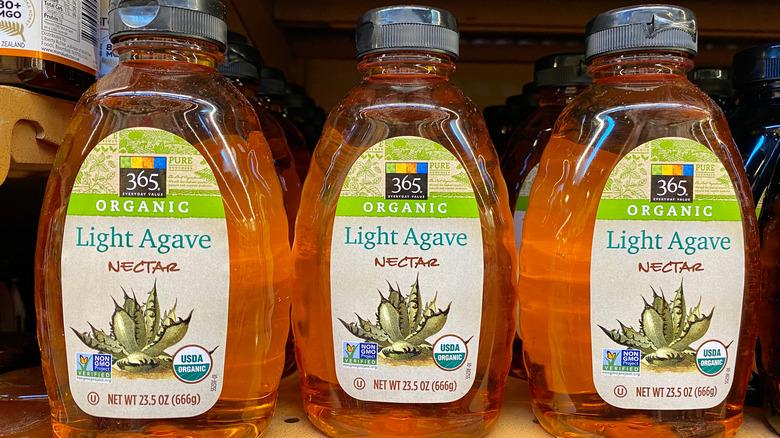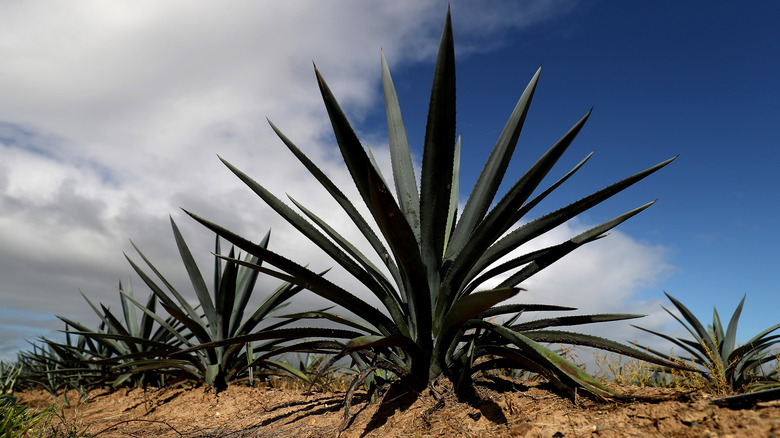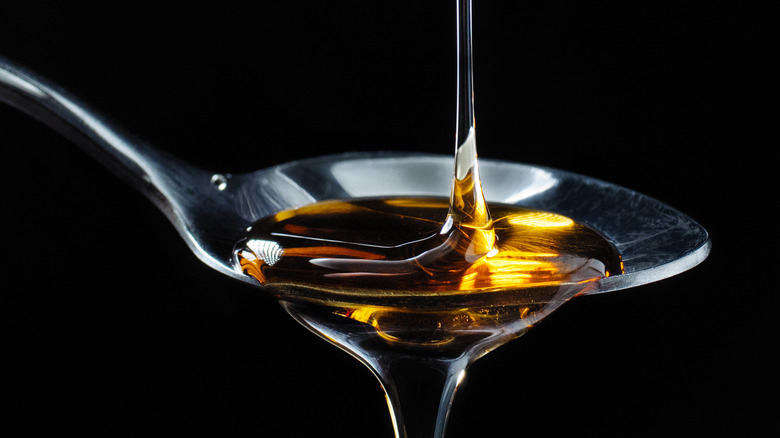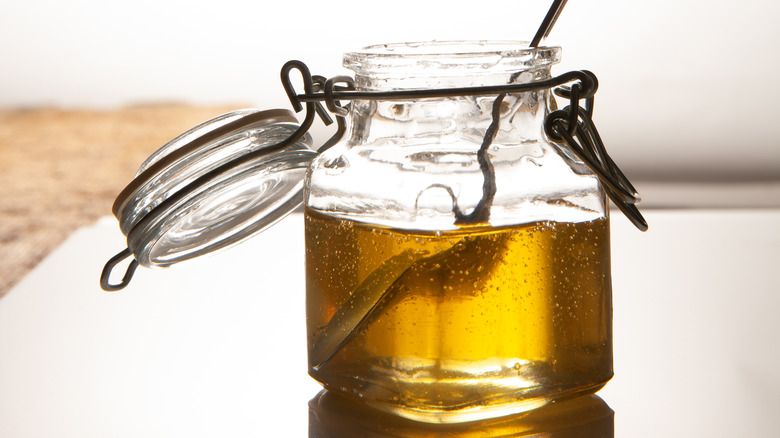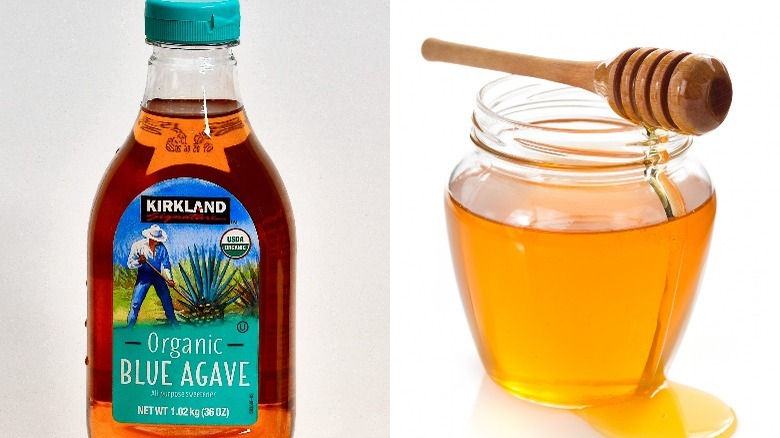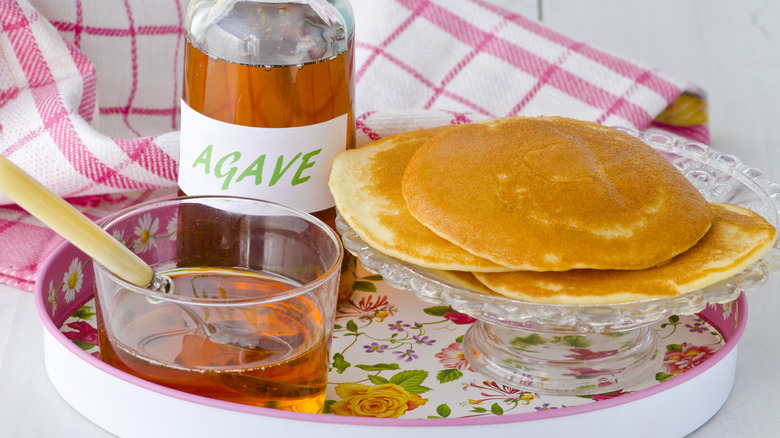What Is Agave Nectar And Is It More Nutritious Than Honey?
Who doesn't love a fresh-baked chocolate chip cookie or a scrumptious bowl of ice cream topped with fluffy whipped cream for dessert? Both are nothing short of delicious, and perfectly fine to enjoy in moderation, but eating too many of these sugary sweets on a regular basis can have some serious effects on our health and can potentially lead to things like weight gain, cavities, and diabetes (via Healthline). Fortunately, there are plenty of ways to modify or lower our sugar intake these days, as the market is saturated with substitutions for the sweet stuff that can allow us to get our fix without having to nix it completely from our diets.
Of the myriad of sugar alternatives out there, agave nectar has become one of the more popular products available, as it is suitable for those following a vegan diet and is also safer for diabetics to eat. However, many experts warn that this seemingly healthy option isn't as miraculous as it may seem. So what exactly is this all-natural sweetener that is being heavily touted in the health-food world, and how does it compare to some of the other sugar substitutes out there, like honey? We have those answers and more.
What is agave nectar?
After spending several years in specialty grocery stores and health food markets, agave nectar is finally making its way into the mainstream retailers, and if you've seen it on the shelf during one of your recent shopping trips you're probably a little curious about what it is. As its name implies, agave nectar is a product derived from the agave plant, which is a large succulent that is native to Mexico and also produces your favorite bottle of tequila or mezcal (via Healthline).
To make agave nectar, the plant is first stripped of its long, sword-like leaves, leaving behind the core of the plant that is rich in a sugary sap that is extracted from the plant. At this point, the sap is high in fructans, which Healthline notes can help improve metabolism and insulin production — sounds great, right? Unfortunately, we don't actually get any of those health benefits, as the fructans are broken down once the sap is heated up and processed, resulting in a sweet syrup that is high in fructose and void of any positive health aspects.
What does agave nectar taste like?
In general, agave nectar has a sweet taste that WebMD says is about 1.5 times more intense than regular table sugar. Its flavor is often likened to that of honey or maple syrup, and unlike other sugar alternatives like stevia, it does not have a bitter aftertaste (via Thrive Cuisine). However, it is important to note that there are four different varieties of agave nectar on the market: light, amber, dark, and raw, each of which have a slightly different taste.
According to Whole and Natural, both light and raw agave nectar are described as having "mild, neutral flavors," meaning they will not alter the taste of the food or beverages they are being added to. The main difference between the two of them is the temperatures at which they are heated to while the syrup is being made; light agave nectar is heated to 161 degree Fahrenheit while raw agave never goes above 118 degrees, making it suitable for those following a raw food diet. Meanwhile, the amber and dark varieties are said to have caramel notes, with dark agave syrup being the more intense of the two.
Nutritional information about agave nectar
Since agave nectar loses many of its health benefits due to being processed, you may be wondering why it has become such a popular alternative to sugar, but there are some positive aspects about the sweet syrup that can make it a good choice. According to WebMD, refined sugar contains around 40 calories per tablespoon while the same amount of agave nectar contains 60 calories. This, of course, doesn't exactly look good on paper, but because agave nectar has a much sweeter taste, you end up using less, therefore saving you a few calories when everything is said and done.
But what about all that fructose in agave nectar? As it turns out, the high level of fructose found in this product also puts it low on the glycemic index, which is a measurement of how sugar in food affects blood sugar (via Healthline). Because of this, agave nectar is appealing to diabetics since it won't cause a rapid spike in blood sugar. However, too much fructose can also lead to some major health problems, especially with your liver, so it is still best to limit the amount of this sweetener you consume.
Agave nectar vs. honey
Agave nectar and honey are potential alternatives to refined sugar that are especially popular because they are all-natural, but when staring at a shelf holding both products, it can be difficult to determine which is the healthier choice of the two. As Healthline notes, a quick glance at the nutrition facts on the back of each bottle will reveal that they hold similar caloric value at around 60 calories per tablespoon. Both are also sweeter than regular table sugar, and can be used in smaller amounts.
At this point, it may seem like you can't go wrong with either option. However, there are some major differences between the two that you should take into account before making your choice. Since honey comes from bees, it is not suitable for those following a vegan diet, making agave nectar the winner for those living the plant-based life. Diabetics will also benefit more from agave nectar since it falls lower on the glycemic index than honey does. On the other hand, Healthline points out that honey contains considerably less fructose than agave nectar, and, according to Food Network, is also high in several minerals such as iron, copper, potassium, and zinc. As we've previously mentioned, most of the health benefits of agave nectar are lost once it is processed, so nutritionally, honey is the better choice.
How to use agave in the kitchen
If you do end up choosing agave nectar as your sweetening agent, there are many ways that you can make use of it in the kitchen. For starters, this product dissolves quickly, making it an excellent sweetener in both hot and cold beverages. Try using it to flavor your morning coffee, and while you're at it, drizzle some on top of a stack of fluffy pancakes or waffles in place of maple syrup.
Agave nectar can also act as a replacement for sugar in just about any scenario from baked goods to savory sauces — Jason Mraz even uses it to make a dessert guacamole that he appropriately calls "chocomole." Just be sure to keep in mind that the syrupy substance is much sweeter than the white sugar you're used to using. To compensate for this, Fine Cooking suggests using ⅔ cup of agave nectar in place of every cup of sugar your recipe calls for while also reducing the other liquids by ¼ cup.
